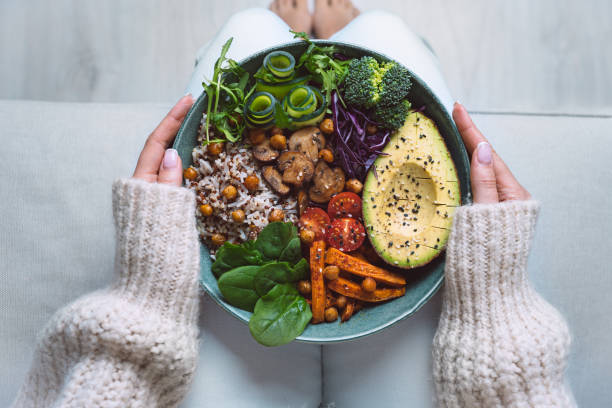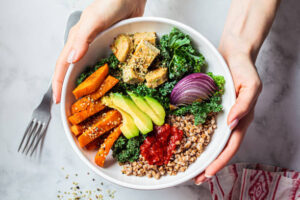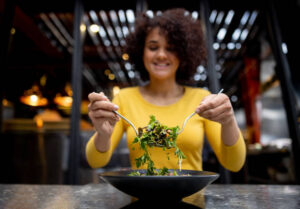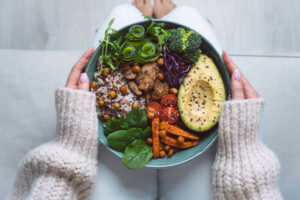Veganism doesn’t have to be a mystery. The process should be simple, fun, and accessible. To help you transition to a plant-based diet, I have created a Comprehensive Guide for Beginners on How to Go Vegan. Let’s dive in!
The vegan movement is growing in every way. A growing number of consumers (about 20%) say they are interested in eating more vegan (or plant-based diet). Nearly half of all major food companies work to create plant-based products and expand into every aisle in grocery stores because plant-based food sales are nine times higher than overall food sales. College and university menus are also evolving, and by 2025, 42% of them will be plant-based.
Finding out how to go vegan can be a little overwhelming, whether you’re ready for a lifetime commitment or just a little curious. The good news: it’s not nearly as hard as you may think, and there are many benefits to becoming vegan, including a smaller carbon footprint and better health.
What is Veganism?
According to The Vegan Society, veganism is a way of living that avoids all forms of animal exploitation and cruelty, including its use as food, clothing, and for any other purpose.
Vegetarianism is fundamentally a diet based on plants, which avoids meat, fish, dairy, and eggs (and often honey as well). Vegans also don’t use leather, wool, silk, or fur, products tested on animals, or products derived from animals. They also don’t visit places that keep or use animals for entertainment, such as zoos, race tracks, or circuses.
How to Become Vegan

Making small steps towards becoming vegan is a tried and true method. You can take these steps on your journey to veganism to help you along the way.
1. Conduct research
You can do research about veganism by using the internet. You can watch documentaries on streaming services, including “Food Inc.” and “Cowspiracy”, to learn more about what motivates you and why you are drawn to veganism. A good place to start reading vegan books is the Food Empowerment Project, which strives to be anti-racist.
2. Clear your fridge
The first thing we did when we became vegan was remove or at least reduce any temptations from our environment related to animal products. As a result, we gave away frozen meat, cheese, sour cream, cow’s milk, you name it, to our families who consume those products. As a result, our habits were rebuilt from scratch.
Your non-vegan neighbors may enjoy your animal-based products if you ask them. While respecting others in your household, clear out as much as possible.
Keeping things simple is a good strategy when restocking your pantry and fridge. Become an organic raw foodie gradually; otherwise, you will burn out and overwhelm yourself.
You should purchase your kitchen necessities at your local zero-waste grocery store. Including vegetables, fruits, nut milks, oils, grains, and canned legumes. It’s best to buy organic when possible, but don’t worry about it too much. Start regardless of the quality of the produce.
3. Don’t rush it
To succeed at a 100% vegan diet, you must break the project down into smaller, more achievable steps as you go through it. You can begin with some of these other ideas. Put them in any order you want, and go as fast or as slowly as you want:
- Make healthy substitutions for two animal-based foods. Make a homemade cashew alfredo sauce instead of your traditional dairy alfredo sauce next time you make pasta! Make your next chili plant-based instead of meat-based. Try substituting sautéed tempeh for ground beef on your next taco night (marinated just like meat).
- Eat as many fruits and vegetables as you can, whether you love them or already have them at home. Your daily plate can be enhanced by adding more vegetables or fruit, as well as fruit smoothies.
- Every week, try a different plant-based food. You might try a new legume or grain for the first time.
- Substitute plant-based alternative foods for traditional meat-based ones, such as hamburgers, pasta, nuggets, and pizza. You can make a vegan pizza with veggies, marinara, cashew sauce, and vegan cheese at home instead of ordering one. Instead of eating these foods every day, try substituting a less processed, plant-based option if you are used to them.
- Choose a natural peanut butter that contains no added sugar, and only nuts or seeds.
- Drink infused water (water flavored with cucumber, strawberry, or blueberry slices) instead of soda.
- If you haven’t cooked a meal at home before, start cooking a few once a week instead of going to restaurants. There is a lot of salt, oil, and sugar in fast foods and restaurant foods to enhance the flavor and prolong their shelf life, not to mention the price. You’ll both benefit from cooking more at home if you do!
Eventually, you’ll notice that many of your unhealthy eating habits have been replaced by healthier ones as you make these incremental changes.
4. Know your reasons
Imagine the world you would like to live in. Do you aspire to live in a world where animals get more dignity and you are not contributing to their suffering? These values motivate long-term vegans to abstain from eating meat.
Health, social justice, or environmental concerns are some of the reasons why people become vegans, in addition to concerns about nonhuman animal suffering. In the past century, veganism has been practiced by religious and spiritual communities all over the world.
5. Plan your strategy
When you don’t have people around you who support veganism, becoming fully vegan can be just as difficult as changing any habit. Animal products are often discarded in phases rather than all at once by less than a third of people.
The majority of people start by making small changes in their lives, such as going vegan for a part of the day or giving up chicken and fish for a week. Your transition to veganism can be easier if you know you’re easing into it at your own pace.
6. Invest in healthy foods
It is cheaper to eat a plant-based diet than an omnivorous one, despite what many people believe. Keeping away from many highly processed vegan substitutes can save you almost $750 a year, according to a study in the Journal of Hunger & Environmental Nutrition.
Ensure that you eat a variety of fruits, vegetables, and whole grains (such as buckwheat, brown rice, quinoa, and amaranth) and legumes (such as black beans, lentils, chickpeas, and soybeans).
As you stock up on healthy food at home, dispose of less healthy items or donate them. As a result, you will not consume them as frequently and your pantry will not overflow.
7. Get Support
When you set goals with others, you have a better chance of achieving them. Professionals or vegan community groups can support you. Healthy, plant-based cooking classes and digital content are often available for free from community groups and coaches. New and existing vegans can find support, advice, and friendship in social groups on Facebook and Meetup.
8. Be easy on yourself
Think of yourself as a dear friend, and treat yourself with kindness. Buddhist psychology teaches self-kindness and self-care as forms of self-compassion. Do you think it would be great to celebrate a friend taking on a new adventure to improve their life? You might have to remind yourself that what you’re doing is replacing what you learned as normal with a new normal. It is important to take time for self-reflection and compassion when making changes, even when they are good.
9. Don’t worry what others think
Many people still think veganism is extreme and/or unhealthy, despite its increasing popularity. There may be some people who laugh at your decision and others who worry that you won’t get the nutrients you need. I find it best just to ignore any negativity and not argue with them about your decision. What matters most is that you’re following your passion.
10. Don’t give up
There’s no shame in making mistakes. Vegans may feel guilty if they fail to achieve their goals. Those feelings are so common that starter kits remind their readers to “remember no one is perfect.” There is no need to beat yourself up if you cheat from time to time. Your next meal can always be a fresh start.
How Veganism Works
Veganism involves consuming plant-based foods and beverages and avoiding any animal products. It may sound simple, but following a vegan diet can be challenging since animal by-products are hidden in so many foods – especially in restaurants.
Rather than just eating vegan food, some people consider veganism a lifestyle. By avoiding leather and fur clothing, beauty products, medications, and beauty products that have been tested on animals, they’ll avoid all animal products in their lives.
What to Eat in a Vegan Diet
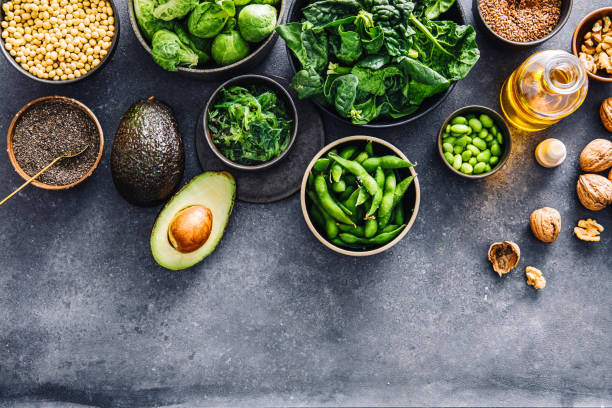
You’re likely wondering what you can eat as a vegan now that you know what you can’t. Plant foods are rich in protein, nutrients, and taste, so they are incredibly delicious. As a vegan, you should focus on:
- Vegetables and fruits: When you become vegan, you’ll benefit from upping your intake of fruits and vegetables, which are full of minerals and vitamins. The fruits and vegetables I like the most are cucumber, lemons, bananas, apples, peppers, frozen berries, onions, dates, aubergines, mushrooms, courgettes, spinach, carrots, lettuce, broccoli, and tomatoes.
- Legumes: A vegan diet relies heavily on these sources of protein and iron. Besides providing protein and iron, beans, lentils, and peas also contain fiber, manganese, zinc, folate, and antioxidants. For legumes to provide the most nutrition, it’s important to rinse and cook them properly. We enjoy kidney beans, chickpeas, split peas, red lentils, black beans, and green peas in our household.
- Seeds and nuts: Nuts also contain fat, iron, fiber, zinc, magnesium, potassium, selenium, vitamin E, and antioxidants, making them a great source of plant-based protein. For a start, you can buy walnuts, cashew nuts, pine nuts, pecan nuts, sesame seeds, pumpkin seeds, chia seeds, and sunflower seeds.
- Grains: There are carbs everywhere. It’s hard not to love carbs, isn’t it? You can use them as a base for meals while following a plant-based diet, and they’ll keep you full. A few staples include rice, pasta, noodles, bread, and quinoa, which is high in protein.
- Milk from plants: Veganism doesn’t mean giving up milk in your cereal or tea in the morning. Cow’s milk can now be replaced by coconut, soy, almond, oat, rice, cashew, and hemp milk, all of which have less impact on the environment. Furthermore, they often contain calcium and vitamins, all of which are helpful for vegans.
- Meat substitutes and tofu: In some ways, tofu is similar to meat when cooked, making it a staple in many vegan diets. Vegan alternatives such as tofu scramble, tofu nuggets, and BBQ tofu can be made with tofu, which is made from soybeans. Meat alternatives include tempeh, a fermented soybean product, and seitan, a wheat-based product. As more and more vegan alternatives become readily available in supermarkets, including vegan sausages, nuggets, burgers, steaks, etc., you can make the switch to veganism easier!
Is There Anything Wrong with a Vegetarian Diet?
Many consumers adopt a vegetarian diet to improve their health by avoiding meat, dairy products, eggs, and honey. Vegetarianism is certainly better for your heart health than eating meat and is widely considered to be a positive change.
A vegan diet, however, offers more benefits than a diet that includes animal products. Since vegan diets do not include eggs and dairy, which contain cholesterol, vegan diets may provide better protection against cardiovascular disease. Dairy consumption causes several health issues, such as type 2 diabetes, Alzheimer’s disease, and certain cancers.
Despite this, a lot of people have found success switching from omnivore diets to vegan diets by first adopting a vegetarian diet. You can take the next step toward going vegan by becoming vegetarian and eliminating meat products.
Vegan Diet Common Results
If you switch to a vegan diet, you will likely notice some changes in your body, no matter who you are. Some of them can be challenging, but most are positive. People who have switched have consistently reported the following experiences.
- Getting more gassy
Plant-based diets are known for their high fiber content. As you eat plants, keep in mind that they are packed with fiber as well as grains, vegetables, and fruits. According to a study, vegans consume the most fiber of all the major food groups, about 41 grams a day.
If you’re not used to that much fiber in your diet, it may take a bit of time for your body to adjust. This will make you gassy and cause you to poop more often. Your body will benefit from a regular schedule, so keep it up!
- Weight loss (getting hungrier)
It can take time to find great alternative foods after eliminating certain foods from your diet. You may be consuming fewer calories daily if you do not consume meat, dairy, or cheese. Having fewer snack options may also lead to you eating less. Initial weight loss or hunger may result from a reduced calorie intake.
A vegan diet containing processed foods and simple carbohydrates may cause you to gain weight, on the other hand. As a result, it’s better to stick to whole food choices when it comes to being plant-based (processed foods aren’t healthy either).
- Better gut health
The microbiome in your gut is full of microbes, so several gastroenterologists recommend a plant-based diet to help your gut bacteria stay healthy. You will improve your immune response when you switch to a vegan diet. In the process of changing your gut microbiome, you may experience more gas (as well as tummy aches), but it will pass.
- Supplements may change
We often take vitamins and minerals daily to ensure our bodies receive all the nutrients they require. Plant-based diets provide your body with almost all of the nutrients it needs. However, there is one exception: B12. In severe cases, a lack of vitamin B12 can lead to neurological problems, metabolic problems, and even death for vegans. Animal products contain this vitamin, so if you don’t eat animals, you’ll need to take B12. Calcium, iron, and omega-3 supplements are also important when changing to a vegan diet.
Final Words
The impact of becoming vegan may surprise you. Veganism means already questioning what is “normal” in society and you are already comfortable with that.
We were able to become vegans due to minimalism. However, a snowball effect followed. There are many ways in which consumerism can be disruptive, from waste to fair trade issues to toxic chemicals.
You are likely sensitive to other issues in our society as a vegan. A sane person can feel overwhelmed by this pressure to be a mindful consumer. Take it step by step, that’s my advice.
It seems there are quite a few things to consider when living a vegan lifestyle after reading this post. Instead of focusing on zero-waste, toxins-free, or fair-trade, make veganism your behavior.
I’m still struggling with this journey if that brings you any comfort. It is always surprising to me that I buy tofu from a supermarket wrapped in soft plastic despite regularly writing about these topics.
Whenever I buy it, I feel guilty. I have learned to not be too hard on myself over time. I take a moment to reflect on my progress. Being more mindful even extends to my guilt about tofu.
Ultimately, here’s what it all boils down to. It’s impossible to be a perfect vegan. Humans are disruptive to our planet because they require resources to live. Isn’t the environment better off if humans didn’t pollute it?
Insects likely die even when you purchase plant-based foods. If you stepped outside, you probably stepped on an insect. You can also kill wildlife in a car accident. Being vegan means reducing as much harm as you can. Don’t be too hard on yourself.
We should repeat it. It’s impossible to be a perfect vegan!

